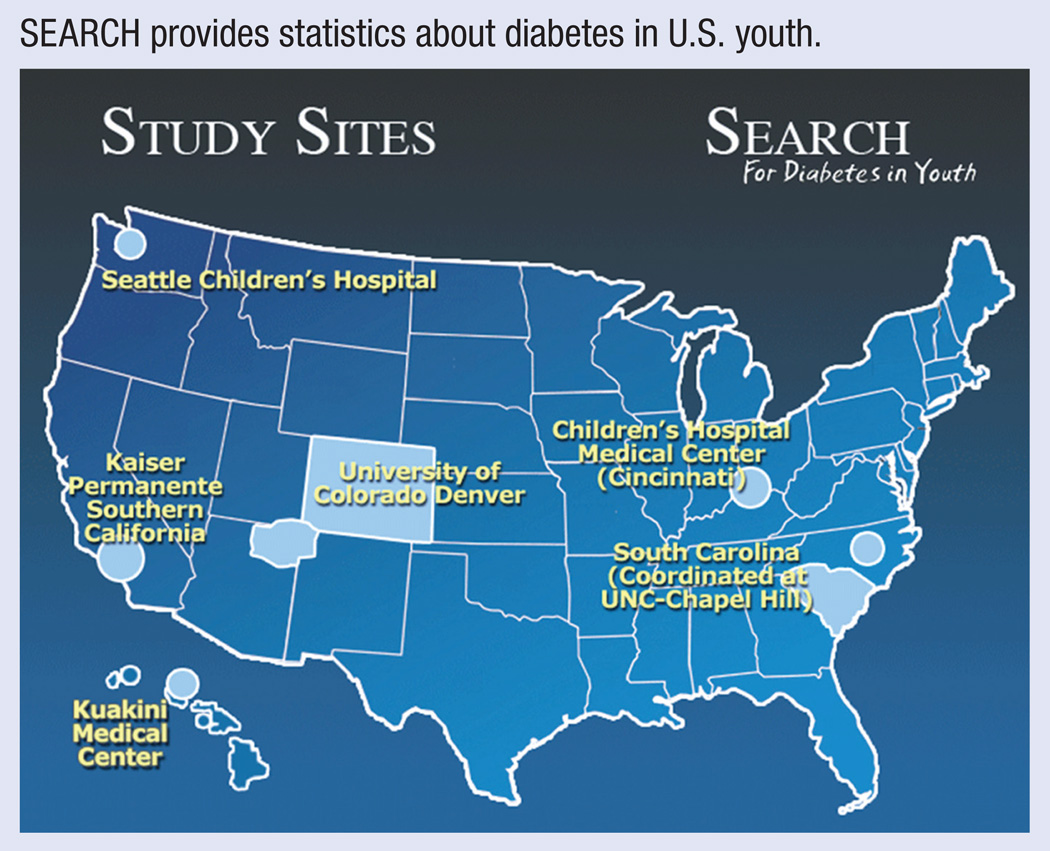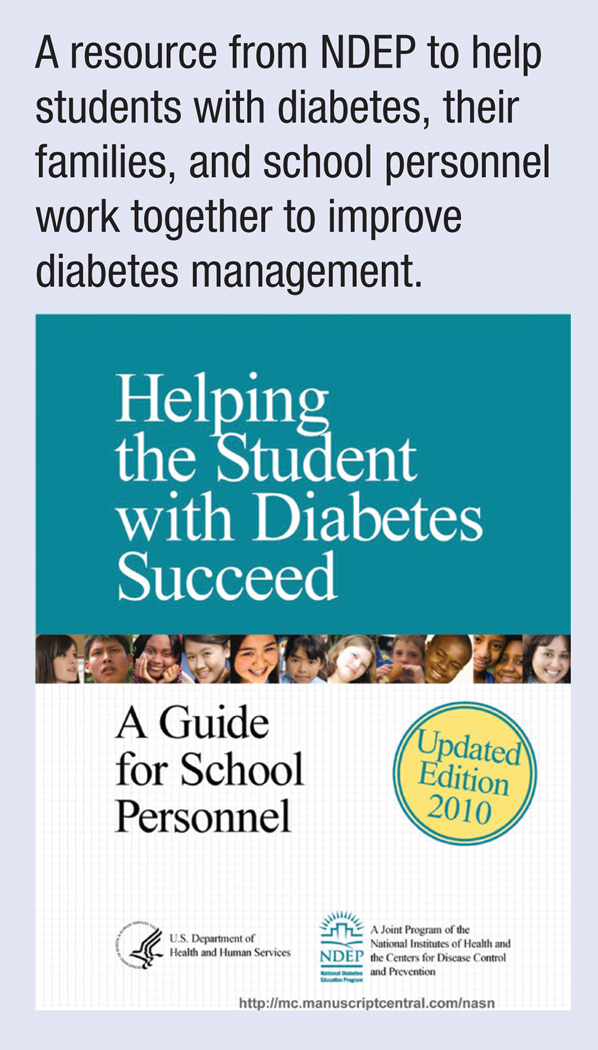Abstract
Major research trials have provided insight into the scope of type 2 diabetes in youth. The National Diabetes Education Program offers resources to help school nurses support children with or at risk for type 2 diabetes.
Keywords: type 2 diabetes, obesity, children, NDEP, diabetes prevention
Once considered a disease of older adults, type 2 diabetes now occurs among youth. This has significant public health consequences, as these youth are likely to develop complications of diabetes, including retinopathy, nephropathy, neuropathy, and cardiovascular disease, at a time that should be the most active and productive of their lives. They will need significant support from their families, medical team, and school community to successfully manage their disease.
To understand the scope of the problem and provide population-based statistics for diabetes in U.S. youth, the SEARCH for Diabetes in Youth study was started in 2000 by the Centers for Disease Control, with co-funding from the National Institute of Diabetes and Digestive and Kidney Diseases (NIDDK). In 2001, there were approximately 154,000 youth under the age of 20 years with diabetes (SEARCH for Diabetes in Youth Study Group et al., 2006). In 2002–2003, approximately 15,000 youth were being newly diagnosed annually with type 1 diabetes and 3,700 with type 2 diabetes (Writing Group for the SEARCH for Diabetes in Youth Study Group et al., 2007).
In non-Hispanic white youth ages 10 to 19 years, 15% of new cases of diabetes are type 2. However, type 2 diabetes predominates in minority youth (86% of new cases among American Indians, 70% among Asian/Pacific Islanders, 58% among Blacks, and 46% among Hispanics). Type 2 diabetes is rarely seen in children younger than 10 years of age, even in minority populations. Nurses in schools with large minority populations should be aware of the increased risk of type 2 diabetes in their student population. Since 2002, SEARCH has been ascertaining new cases of diabetes annually and will soon provide updated data to address whether type 2 diabetes is increasing. SEARCH has also described in detail the characteristics of youth with type 2 diabetes. Perhaps of greatest concern is that 27% of the youth with type 2 diabetes enrolled in SEARCH had poor glycemic control (A1C > 9.5%), with the highest rates among youth from racial/ethnic minority groups (Petitti et al., 2009).
The level of poor glycemic control in youth with type 2 diabetes highlights the need for prevention of type 2 diabetes and of obesity, which puts people at risk for developing type 2 diabetes. Schools have an opportunity to reduce diabetes risk because of the large amount of contact time they have with youth.
In 2006, the NIDDK, with support from the American Diabetes Association, sponsored the HEALTHY study to evaluate a randomized, 3-year, school-based program to decrease risk factors for type 2 diabetes. The HEALTHY intervention provided healthier choices from the cafeteria and vending machines (e.g., lower fat foods, more fruits and vegetables, and drinks with no added sugar), longer and more intense periods of physical activity in physical education classes, and activities and awareness campaigns that promote long-term healthy behaviors. Forty-two middle schools were randomized; half received the intervention and half served as comparison schools. Over 70% of the 4,603 students in the HEALTHY cohort were eligible for free or reduced-price meals and were either Black or Hispanic. Half of the cohort was either overweight or obese at the beginning of the study in 6th grade, based on body mass index. The primary outcome was the combined rate of overweight and obesity (HEALTHY Study Group et al., 2010). The combined number of overweight and obese students declined by 4% in both the intervention and comparison schools. However, the prevalence of obesity declined significantly more in the intervention schools among students who were overweight or obese at the onset of the study. Decreasing the number of obese children could have significant effects in the population risk of diabetes, since obese children have the highest risk of developing type 2 diabetes.
While prevention remains a priority, optimal treatment for youth with type 2 diabetes must be provided. Currently, metformin is the only oral agent approved by the Food and Drug Administration for use in children. Treatment paradigms must be developed with consideration given to the physiological and psychological changes that occur during adolescence. To test the value of early aggressive therapy, NIDDK funded the TODAY (Treatment Options for type 2 Diabetes in Adolescents and Youth) Study (TODAY Study Group et al., 2012), which randomized 699 youth ages 10 to 17 with less than 2 years of diabetes to metformin monotherapy, metformin plus rosiglitazone, or metformin plus an intensive lifestyle program. The TODAY cohort was predominately minority (32% African American, 41% Hispanic, 6% American Indian) and of low socio-economic status (42% with household income <$25,000), reflecting the increased risk of type 2 diabetes in these groups. The primary outcome was the time to treatment failure, defined as an A1C > 8.0% for 6 months. Half of the metformin group was unable to maintain glycemic control. The failure rate of metformin monotherapy was much higher than anticipated based on published information in adults with type 2 diabetes. The addition of rosiglitazone decreased the failure rate by 25% (51.7% in the metformin group versus 38.6% in the metformin and rosiglitazone group). The metformin plus lifestyle group was intermediate (46.6%) but not statistically different from the metformin alone group. Of note, African American youth had a failure rate of 66% on metformin monotherapy, highlighting the need to individualize therapy. Further analyses are currently being conducted to understand the reason for racial/ethnic differences in response to treatment. The level of comorbidities in TODAY participants is also concerning. By the end of the study, 33.8% had hypertension, 28% had high triglycerides, and 16.6% had microalbuminuria, underscoring the need for better treatment approaches.
The SEARCH study continues to illuminate the problem of type 2 diabetes in children. HEALTHY and TODAY were major trials that inform health professionals about prevention and treatment of type 2 diabetes in children. To further enhance understanding of diabetes in youth and treatment strategies, the National Diabetes Education Program (NDEP) provides a resource for school personnel entitled
Helping the Student with Diabetes Succeed: A Guide for School Personnel
School nurses can lead efforts to influence youth behaviors and prevent or manage obesity and type 2 diabetes. The NDEP can provide support with multiple tools and resources at http://www.yourdiabetesinfo.org. For example, Tips for Teens is a series of publications with action-oriented messages designed for multi-cultural youth to increase their physical activity levels, eat a healthier diet, and manage their weight.
The NDEP also offers Diabetes HealthSense, which connects nurses to both online and written resources for assisting students and families with changing behaviors to improve diabetes management. One such tool is BAM! Body and Mind, an interactive website designed for 9- to 13-year-olds featuring games and activities to encourage children to make healthier lifestyle choices. In addition, all HEALTHY materials are available for free at http://www.healthystudy.org. School nurses may find it helpful to become acquainted with these resources as they contribute to the development of healthy lifestyles in youth.
Figure 1.
Figure 2.
Figure 3.
Figure 4.
Biographies
Dr. Linder is the senior advisor for childhood diabetes research at the National Institute of Diabetes and Digestive and Kidney Diseases, National Institutes of Health. She also serves on the National Diabetes Education Program’s Children and Adolescents Stakeholder Group.
Dr. Imperatore is a medical epidemiologist and serves as team leader for the Epidemiology Team with the Division of Diabetes Translation at the Centers for Disease Control and Prevention.
Footnotes
The findings and conclusions in this report are those of the authors and do not necessarily represent the official positions of the Centers for Disease Control and Prevention and the National Institute of Diabetes and Digestive and Kidney Diseases.
Contributor Information
Barbara Linder, Senior Advisor for Childhood Diabetes Research, National Institute of Diabetes and Digestive and Kidney Diseases, National Institutes of Health, Bethesda, MD.
Giuseppina Imperatore, Team Leader, Epidemiology Team, Division of Diabetes Translation, U.S. Centers for Disease Control and Prevention, Atlanta, GA.
References
- HEALTHY Study Group. Foster GD, Linder B, Baranowski T, Cooper DM, Goldberg L, Hirst K. A school-based intervention for diabetes risk reduction. The New England Journal of Medicine. 2010;363(5):443–453. doi: 10.1056/NEJMoa1001933. [DOI] [PMC free article] [PubMed] [Google Scholar]
- Petitti DB, Klingensmith GJ, Bell RA, Andrews JS, Dabelea D, Imperatore G SEARCH for Diabetes in Youth Study Group. Glycemic control in youth with diabetes: The SEARCH for Diabetes in Youth Study. Journal of Pediatrics. 2009;155(5):668–672. e661–e663. doi: 10.1016/j.jpeds.2009.05.025. [DOI] [PMC free article] [PubMed] [Google Scholar]
- SEARCH for Diabetes in Youth Study Group. Liese AD, D’Agostino RB, Jr, Hamman RF, Kilgo PD, Lawrence JM, Williams DE. The burden of diabetes mellitus among US youth: Prevalence estimates from the SEARCH for Diabetes in Youth Study. Pediatrics. 2006;118(4):1510–1518. doi: 10.1542/peds.2006-0690. [DOI] [PubMed] [Google Scholar]
- TODAY Study Group. Zeitler P, Hirst K, Pyle L, Linder B, Copeland K, Kaufman F. A clinical trial to maintain glycemic control in youth with type 2 diabetes. The New England Journal of Medicine. 2012;366(24):2247–2256. doi: 10.1056/NEJMoa1109333. [DOI] [PMC free article] [PubMed] [Google Scholar]
- Writing Group for the SEARCH for Diabetes in Youth Study Group. Dabelea D, Bell RA, D’Agostino RB, Jr, Imperatore G, Johansen JM, Waitzfelder B. Incidence of diabetes in youth in the United States. The Journal of the American Medical Association. 2007;297(24):2716–2724. doi: 10.1001/jama.297.24.2716. [DOI] [PubMed] [Google Scholar]






